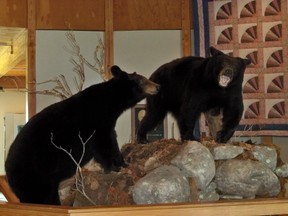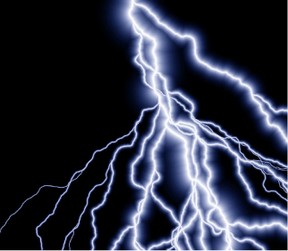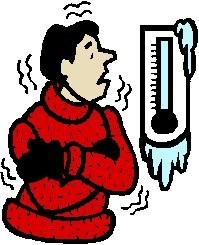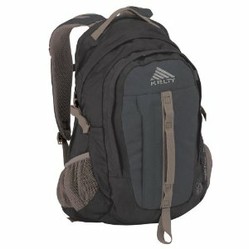 In general, the old saying is true - animals are more afraid of you than you are of them. There are a couple of exceptions, which I'll discuss below, but be aware that in most cases it doesn't matter if an animal is afraid of you or not; many can still hurt you. So here are tips for dealing with four types of wildlife you may find in the woods.
In general, the old saying is true - animals are more afraid of you than you are of them. There are a couple of exceptions, which I'll discuss below, but be aware that in most cases it doesn't matter if an animal is afraid of you or not; many can still hurt you. So here are tips for dealing with four types of wildlife you may find in the woods.
Bears
Ask people what dangers exist in the woods, and many would first say "bears." But in reality, there's little danger of being attacked by a bear. Most bears don't want to meet you any more than you want to meet them.
My Dad used to tell the story of seeing a black bear in the Pennsylvania mountains. Dad immediately turned and ran. Looking back over his shoulder he saw the bear running too . . . in the opposite direction! The bear wanted nothing more to do with Dad than Dad with the bear. With respect to my late father, running from the bear wasn't the best course of action. Usually bears will avoid humans. The exception, of course, is getting between a mother and her cubs.
If a bear does act assertively toward you, talk to the animal and back away slowly. According to the National Park Conservation Association, if a black bear attacks, you should fight back. But if attacked by a grizzly, play dead.
Snakes
I hate snakes! I admit it. Yet an inevitable part of hiking or biking is seeing snakes. In fact, I've seen so many snakes I guess I'm starting to get used to them; they don't scare me as much as they used to. But I still am a bit wary about seeing them, even though I know that the chance of a bite from a venomous snake is small.
If you're hiking in the U.S., there are only four types of venomous snakes to watch for: rattlesnakes, copperheads, coral snakes and water moccasins, which are sometimes called cottonmouths. (There are numerous subspecies though.) About 8,000 people in the U.S. are bitten by venomous snakes each year; seven to ten of those people die from the bite.
In most snakebite cases, the victim was attempting to pick up, kill or otherwise disturb the snake. The best way to avoid snakebite, then, is obvious: leave them alone.
Dogs
Although they're not wildlife, domesticated dogs can be dangerous to hikers, too. Just about every hiker has been approached by dogs on the trail. One question when a dog approaches is this: Is the animal a friend or a foe? Sometimes you can't tell until he's got his fangs in your nice, juicy leg.
Some hikers recommend carrying pepper spray to discourage dogs, but I see three problem with sprays.
* They are an extra expense
* They are extra weight to carry
* You have to take the time to grab the spray when attacked
Instead, I suggest using a hiking stick for protection. Chances are you are carrying a stick anyway, so it serves double duty. I've found that swinging a hiking stick at a dog discourages the most ferocious animal. I've never had to actually hit a dog with my hiking stick, although I'm prepared to do so if necessary. I have swung a stick back and forth like a sword at dogs as they've charged, and found that action to be quite effective in stopping the animal in its tracks. I can almost see the dog thinking, "You know, it might not be a good idea to continue this. I think I'll back off."
Another advantage to a hiking stick: if the dog turns out to be friendly you won't hurt it. Such is not the case with pepper spray.


 Hiking in the woods often involves looking at beautiful scenery, especially if you're in the mountains. The tendency, then, is to look around at the views such as the one on the right, which is on the Appalachian Trial between Newfound Gap and Charlie's Bunion. That's great, but it's too easy to therefore ignore the dangers of being on a hiking trail. Those dangers include rocks, ruts, roots, rattlesnakes and rabbits. (Well, rabbits may be overrated as a danger, but the others are very real!)
Hiking in the woods often involves looking at beautiful scenery, especially if you're in the mountains. The tendency, then, is to look around at the views such as the one on the right, which is on the Appalachian Trial between Newfound Gap and Charlie's Bunion. That's great, but it's too easy to therefore ignore the dangers of being on a hiking trail. Those dangers include rocks, ruts, roots, rattlesnakes and rabbits. (Well, rabbits may be overrated as a danger, but the others are very real!)



 Yes, I know all the anti-technology arguments. "Technology ruins the experience." "Technology annoys others." "My great-grandfather spent his whole life in the woods and he didn't have a cell phone." "Blah, blah, blah."
Yes, I know all the anti-technology arguments. "Technology ruins the experience." "Technology annoys others." "My great-grandfather spent his whole life in the woods and he didn't have a cell phone." "Blah, blah, blah." Hypothermia occurs when your body loses heat and body temperature drops below 95 degrees F. Contrary to popular belief, hypothermia doesn't occur only in temperatures that are freezing or below. It can happen in relatively moderate temperatures, especially if the hiker gets wet. Left untreated, hypothermia can result in death.
Hypothermia occurs when your body loses heat and body temperature drops below 95 degrees F. Contrary to popular belief, hypothermia doesn't occur only in temperatures that are freezing or below. It can happen in relatively moderate temperatures, especially if the hiker gets wet. Left untreated, hypothermia can result in death. The conventional wisdom when thunderstorms approach is to get inside a building. Obviously, that's often not feasible when you're hiking because you may be far from any building. So, how can you protect yourself?
The conventional wisdom when thunderstorms approach is to get inside a building. Obviously, that's often not feasible when you're hiking because you may be far from any building. So, how can you protect yourself?

 How to write concisely, yet wellon 01/17/2014
How to write concisely, yet wellon 01/17/2014



Comments
What a great article. It definitely pays to be careful.
I love the outdoors, hiking repelling and exploring are three of my favorite outdoor adventures. Thanks for the useful tips to stay safe and sound. :)K